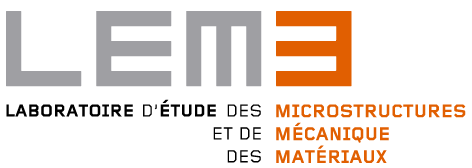- 1st floor meeting room, LEM3 – site Metz Technopôle, 7 rue Félix Savart, 57070 Metz
Abstract
The interaction between grain boundaries (GBs) and dislocations is a key problem in materials science and mechanics. Pile up of dislocations around GBs gives raise to the Hall-Petch effect; a microstructure with small grains has more GBs that act as barriers causing dislocation pile-up resulting in a higher yield strength compared to a microstructure with bigger grains. However, the Hall-Petch relation does not always hold as GBs have complex interactions with dislocations, such as absorption of dislocations, which can change the GB structure, and is sometimes followed by dislocation emission in adjacent grains producing a change in the properties of the material. Additively manufactured samples and nano-metallic laminates are examples of systems with more complex and denser GB patterns in the material. For this reason, GBs play a more important role, and it is important to account for dislocation-GB interactions when predicting the final properties of materials. The improvement of classic computational methods is necessary to include a treatment of GBs with the aim of being able to predict and engineer GB patterns that enhance the properties of materials.
In this work, we present a crystal plasticity model with dislocation transport within and across the grains called DiscoFlux. DiscoFlux combines continuum dislocation transport and transfer, crystal plasticity and considers stress and deformation fields to simulate material response. Dislocation transport is modeled by solving an advection equation, dislocation transfer is modeled using an interface diffusion transfer model and crystal plasticity is coupled to dislocation transport using Orowan’s equation.
While transmission criteria are mainly focused on geometrical factors using the orientation of the slip systems and grain boundary normal. In this work, we extend the transmission criterion by considering energy terms that describes the energy of the dislocation core and the energy barrier produced by the GBs.
About the speaker
Brayan Murgas is a postdoctoral researcher at Los Alamos National Laboratory in the X-Computational Physics group (XCP-5), working on the development of models that consider grain boundary dislocation interactions using phase field dislocation dynamics and crystal plasticity. With a background in mechanical engineering and materials science, he specializes in the link between microstructure and mechanical properties of materials, and the effect of grain boundary properties during metal forming. He is interested in a wide range of physical phenomena, from atomic descriptions to large-scale structures.
To attend on teams
It is also possible to attend the seminar on Microsoft Teams.





